Influence of Aggregate Gradation on the Engineering Properties of Lightweight Aggregate Concrete
Abstract
:1. Introduction
2. Experimental Details
3. Results and Discussion
3.1. Influence of Aggregates’ Gradation on the Properties of Fresh Concrete
3.2. Influence of Aggregates’ Gradation on the Properties of Concrete Strength
3.3. Influences of Aggregates’ Gradation on the Durability of Concrete
4. Conclusions
- Whether NWC or LWAC, the larger SSA coarse aggregates provide better concrete workability. Workability decreases when aggregates are of uniform grade and small grain size.
- LWAC used lightweight aggregates with uniform grade and less than 11 mm grain size obtained higher compressive strength than that using standard grade aggregates. It is advantageous to increase the compressive strength by using smaller grain size aggregates. However, this tendency does not occur in NWC.
- According to the representations of compressive strength, this research recommends that the requirement for aggregates grade for LWAC should not be the same as that of NWC.
- In LWAC proportioning (low w/c), if the major concern is concrete strength, the standard gradation advised by ASTM could not be followed.
- The interface zone between mortar and aggregates of LWAC is comparatively dense. The water permeation of LWAC will be less, and the electrical resistance will be higher than those of NWC. The permeability and electrical resistance of LWAC will be improved as the grain size decreases.
Author Contributions
Funding
Acknowledgments
Conflicts of Interest
References
- China National Standards, CNS 3691 A2046, Lightweight Aggregates for Structural Concrete. 1974. Available online: https://www.bsmi.gov.tw/wSite/mp?mp=2 (accessed on 8 August 2018).
- DIN 1045, Befon und stahlleichtbeton, Bemessmmg und Ausfuehrung. 1970. Available online: https://www.umwelt-online.de/recht/bau/din/4219_ges.htm (accessed on 8 August 2018).
- ASTM C330/C330M-17a, Standard Specification for Lightweight Aggregates for Structural Concrete. 2017. Available online: https://www.astm.org/Standards/C330.htm (accessed on 8 August 2018).
- He, Y.; Zhang, X.; Zhang, Y. Effects of Particle Characteristics of Lightweight Aggregate on Mechanical Properties of Lightweight Aggregate Concrete. Constr. Build. Mater. 2014, 72, 270–282. [Google Scholar] [CrossRef]
- Zaetang, Y.; Wongsa, A.; Sata, V. Use of Lightweight Aggregates in Pervious Concrete. Constr. Build. Mater. 2013, 48, 585–591. [Google Scholar] [CrossRef]
- Shafigh, P.; Jumaat, M.Z.; Mahmud, H.B.; Hamid, N.A.A. Lightweight Concrete Made from Crushed Oil Palm Shell: Tensile Strength and Effect of Initial Curing on Compressive Strength. Constr. Build. Mater. 2012, 27, 252–258. [Google Scholar] [CrossRef]
- Bogas, J.A.; Gomes, M.G.; Real, S. Capillary Absorption of Structural Lightweight Aggregate Concrete. Mater. Struct. 2015, 48, 2869–2883. [Google Scholar] [CrossRef]
- Chung, S.Y.; Elrahman, M.A.; Stephan, D. Effect of Different Gradings of Lightweight Aggregates on the Properties of Concrete. Appl. Sci. 2017, 7, 585. [Google Scholar] [CrossRef]
- Khademi, F.; Akbari, M.; Jamal, S.M. Prediction of Compressive Strength of Concrete by Data-Driven Models. Civ. Eng. 2015, 5, 16–23. [Google Scholar] [CrossRef]
- Nikoo, M.; Torabian, M.F.; Sadowski, L. Prediction of Concrete Compressive Strength by Evolutionary Artificial Neural Networks. Adv. Mater. Sci. Eng. 2015, 2015, 849126. [Google Scholar] [CrossRef]
- Sarıdemir, M. Predicting the Compressive Strength of Mortars Containing Metakaolin by Artificial Neural Networks and Fuzzy Logic. Adv. Eng. Softw. 2009, 40, 920–927. [Google Scholar] [CrossRef]
- Khademi, F.; Akbari, M.; Jamal, S.M.; Nikoo, M. Multiple Linear Regression, Artificial Neural Network, and Fuzzy Logic Prediction of 28 Days Compressive Strength of Concrete. Front. Struct. Civ. Eng. 2017, 11, 90–99. [Google Scholar] [CrossRef]
- Singh, B.G. Specific Surface of Aggregate Applied to Mix Proportioning. ACI J. Proc. 1959, 55, 893–901. [Google Scholar]
- Zhang, M.H.; Gjvorv, O.E. Mechanical Properties of High-Strength Lightweight Concrete. ACI Mater. J. 1991, 88, 240–247. [Google Scholar]
- Chen, H.J.; Yen, T.; Lia, T.P.; Huang, Y.L. Determination of the Dividing Strength and its Relation to the Concrete Strength in Lightweight Aggregate Concrete. Cem. Concr. Comp. 1999, 21, 29–37. [Google Scholar] [CrossRef]
- Chen, H.J.; Yen, T.; Chen, K.H. Evaluating Elastic Modulus of Lightweight Aggregate. ACI Mater. J. 2003, 100, 108–113. [Google Scholar]
- Wu, T.; Wei, H.; Liu, X.; Xing, G.H. Factors Influencing the Mechanical Properties of Lightweight Aggregate Concrete. Indian J. Eng. Mater. Sci. 2016, 23, 301–311. [Google Scholar]
- Zhang, L.H.; Zhang, Y.S.; Liu, C.B.; Liu, L.B.; Tang, K.J. Study on Microstructure and Bond Strength of Interfacial Transition Zone between Cement Paste and High-Performance Lightweight Aggregates Prepared from Ferrochromium Slag. Constr. Build. Mater. 2017, 142, 31–41. [Google Scholar] [CrossRef]
- Shafigh, P.; Jumaat, M.Z.; Mahmud, H. Effect of Replacement of Normal Weight Coarse Aggregate with Oil Palm Shell on Properties of Concrete. Arab. J. Sci. Eng. 2012, 37, 955–964. [Google Scholar] [CrossRef]
- Rathish, K.P.; Krishna, R.M.V. A Study on the Effect of Size of Aggregate on the Strength and Sorptivity Characteristics of Cinder based Light Weight Concrete. Res. J. Eng. Sci. 2012, 1, 27–35. [Google Scholar]
- Malesev, M.; Radonjanin, V.; Lukic, I.; Bulatovic, V. The Effect of Aggregate, Type and Quantity of Cement on Modulus of Elasticity of Lightweight Aggregate Concrete. Arab. J. Sci. Eng. 2014, 39, 705–711. [Google Scholar] [CrossRef]
- Shafigh, P.; Ghafari, H.; Mahmud, H.B.; Jumaat, M.Z. A Comparison Study of the Mechanical Properties and Drying Shrinkage of Oil Palm Shell and Expanded Clay Lightweight Aggregate Concretes. Mater. Des. 2014, 60, 320–327. [Google Scholar] [CrossRef]
- Wasserman, R.; Bentur, A. Interfacial Interactions in Lightweight Aggregate Concrete and their Influence on the Concrete Strength. Cem. Concr. Comp. 1996, 18, 67–76. [Google Scholar] [CrossRef]
- Kohno, K.; Okamoto, T.; Isikawa, Y.; Sibata, T.; Mori, H. Effects of Artificial Lightweight Aggregate on Autogenous Shrinkage of Concrete. Cem. Concr. Res. 1999, 29, 611–614. [Google Scholar] [CrossRef]
- Youm, K.S.; Moon, J.; Cho, J.Y.; Kim, J.J. Experimental Study on Strength and Durability of Lightweight Aggregate Concrete Containing Silica Fume. Constr. Build. Mater. 2016, 114, 517–527. [Google Scholar] [CrossRef]
- Shafigh, P.; Nomeli, M.A.; Alengaram, U.J.; Mahmud, H.B.; Jumaat, M.Z. Engineering Properties of Lightweight Aggregate Concrete Containing Limestone Powder and High Volume Fly Ash. J. Clean. Prod. 2016, 135, 148–157. [Google Scholar] [CrossRef]
- Farahani, J.N.; Shafigh, P.; Alsubari, B.; Shahnazar, S.; Mahmud, H.B. Engineering Properties of Lightweight Aggregate Concrete Containing Binary and Ternary Blended Cement. J. Clean. Prod. 2017, 149, 976–988. [Google Scholar] [CrossRef]
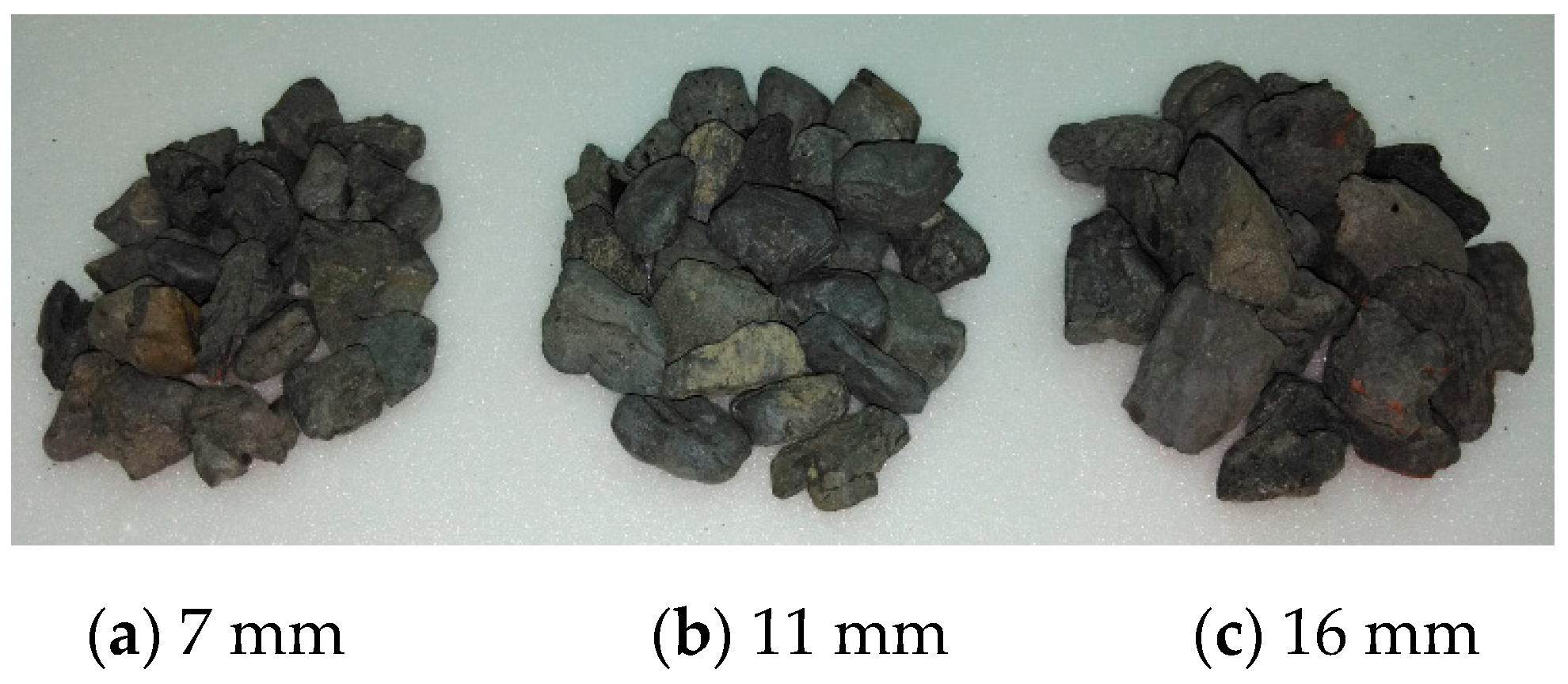
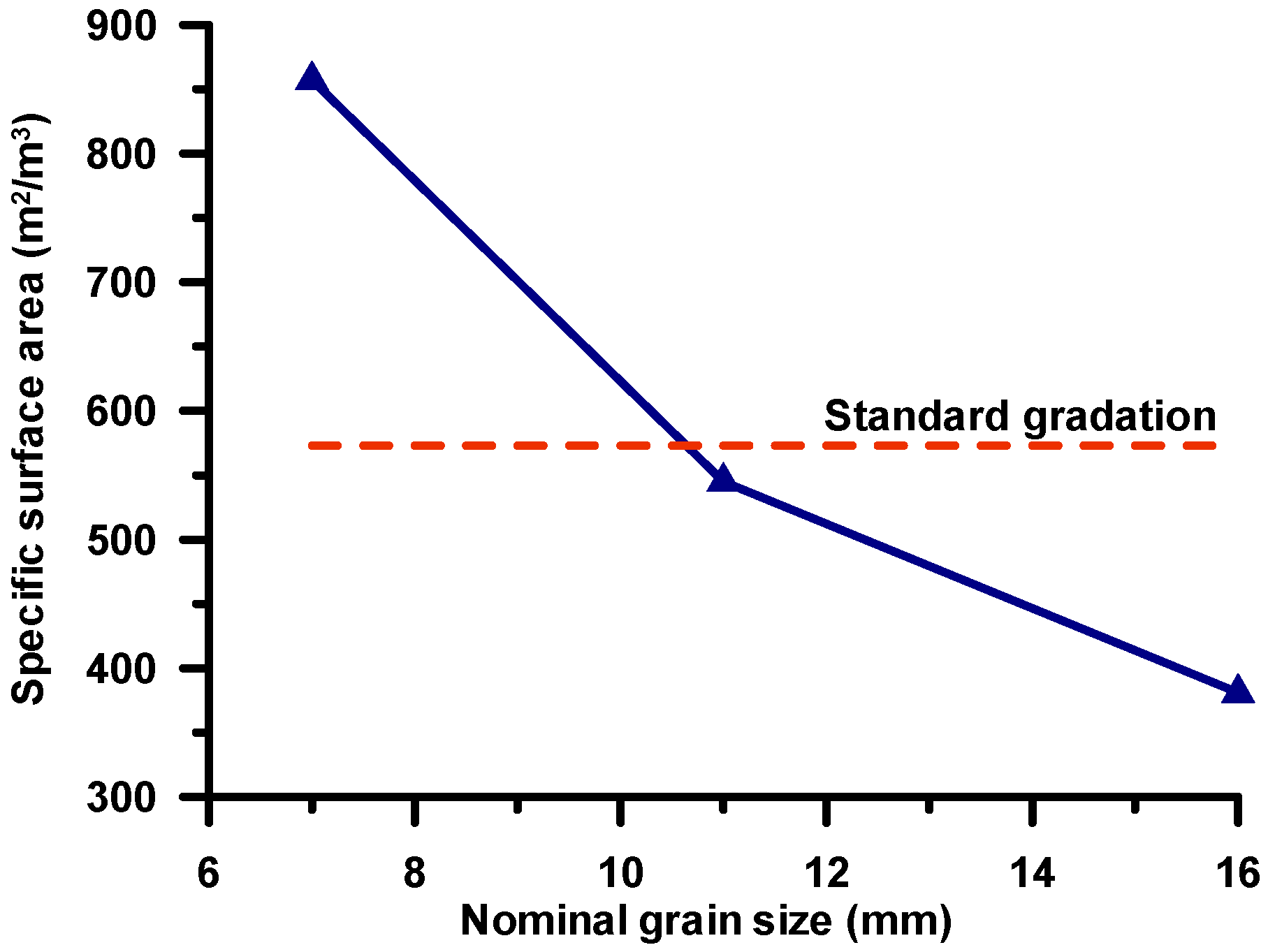
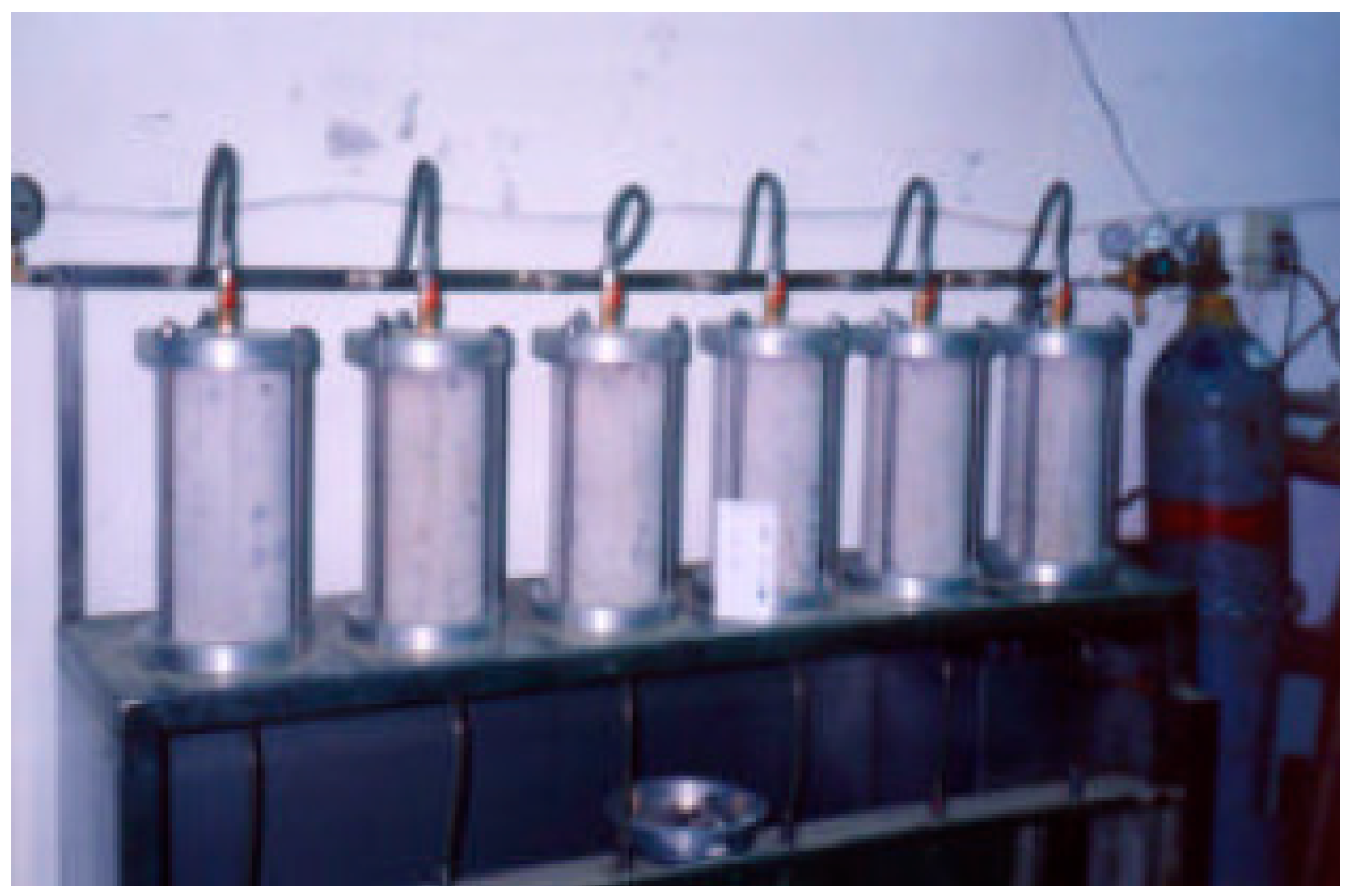
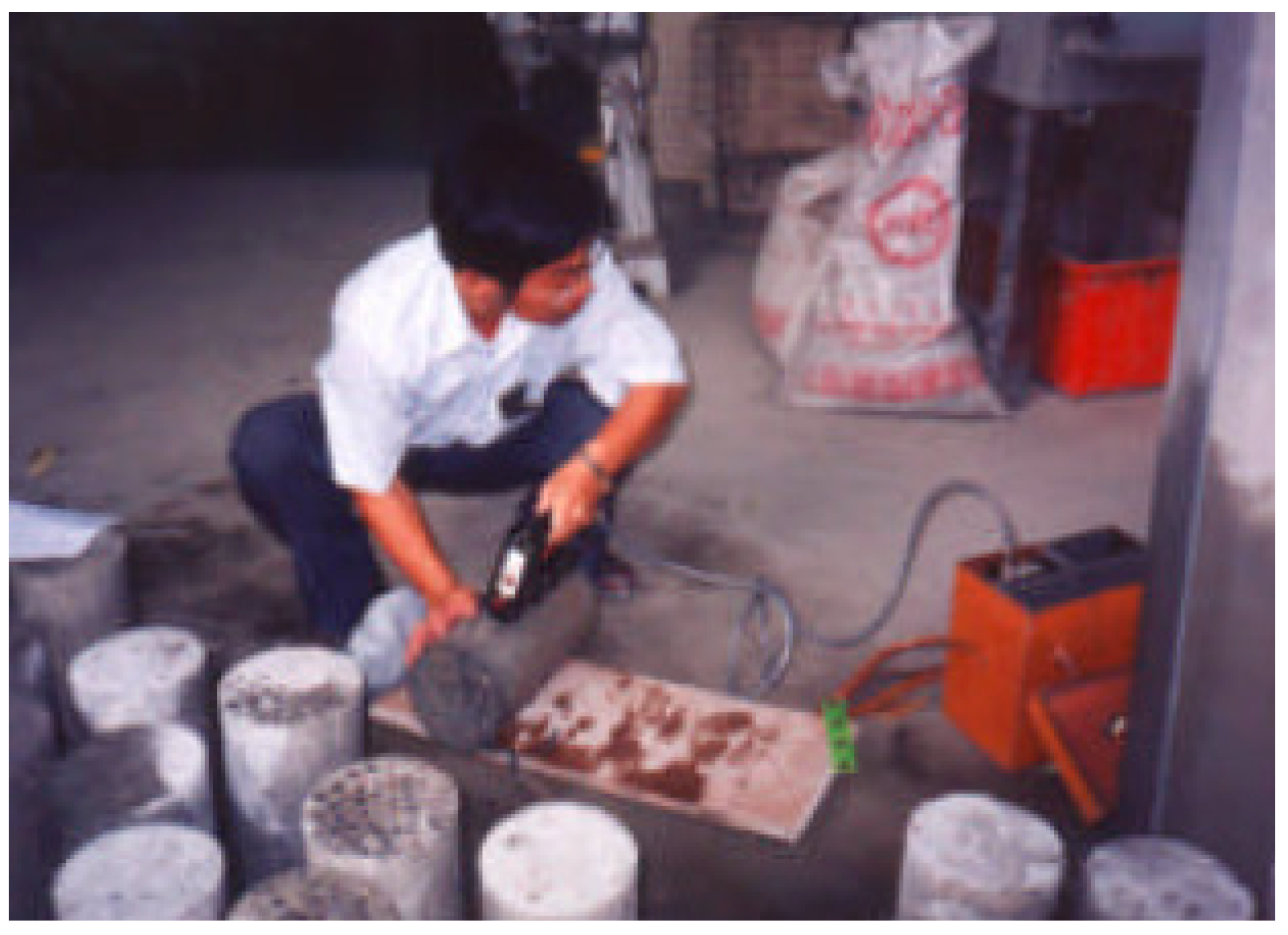

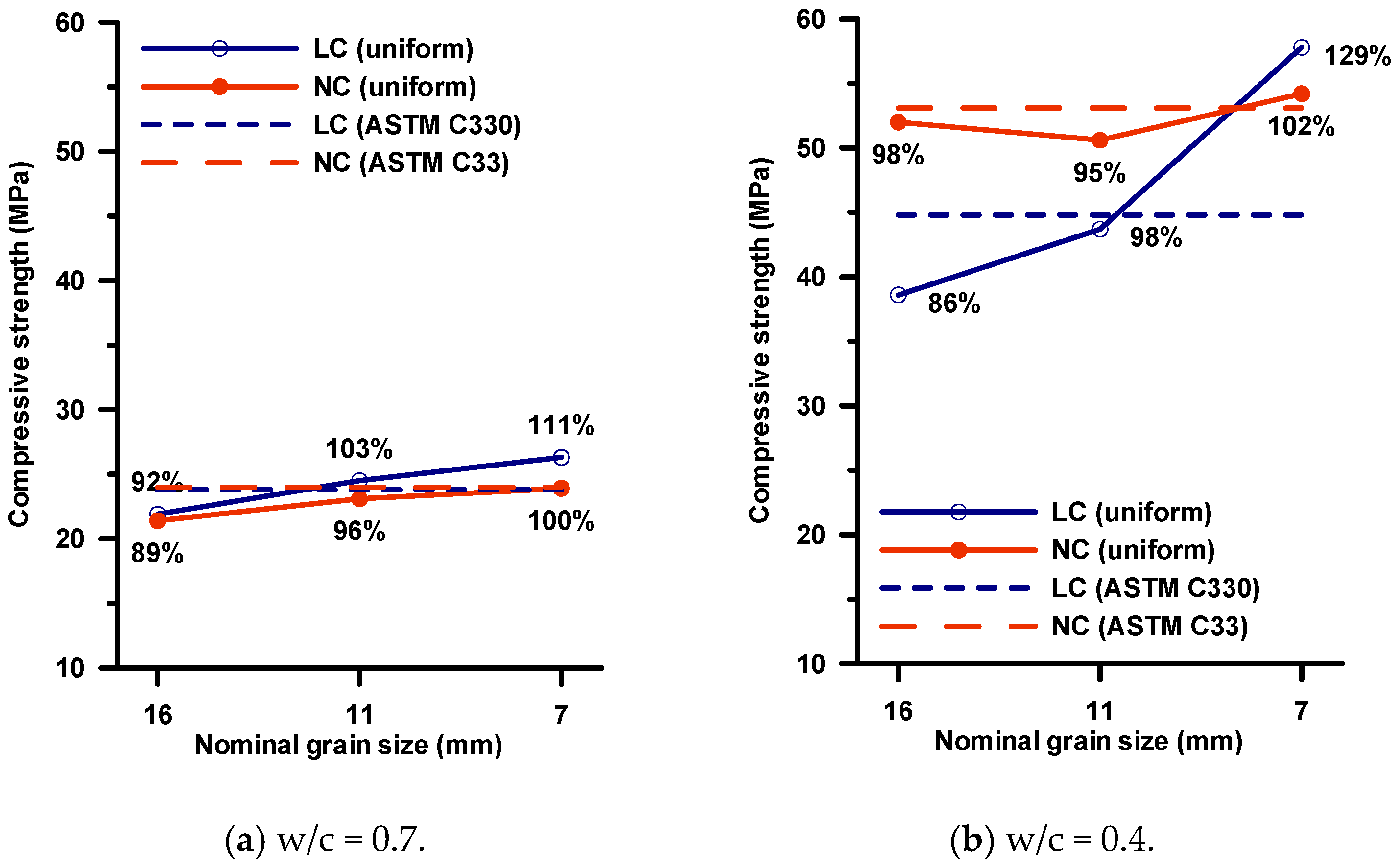
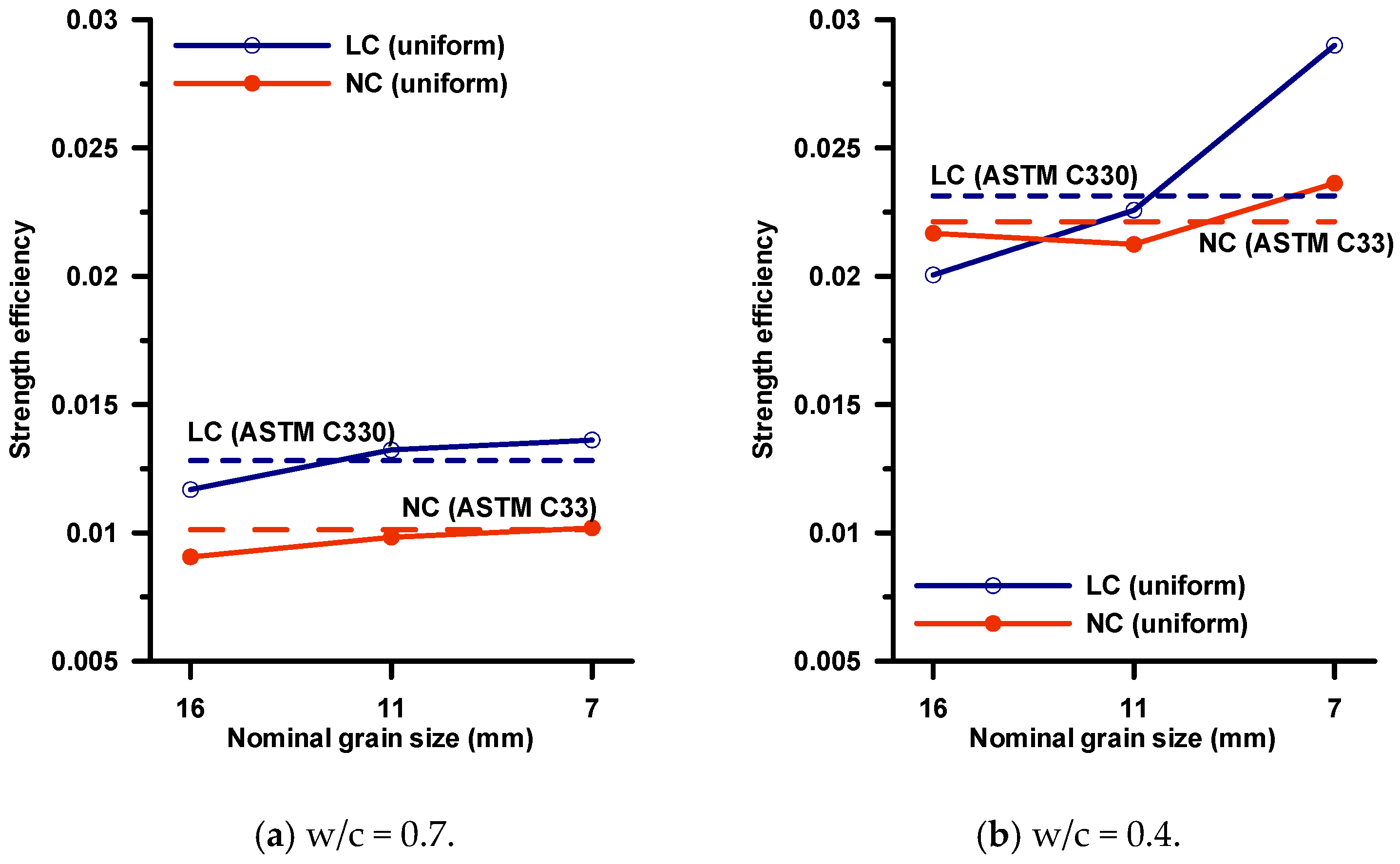
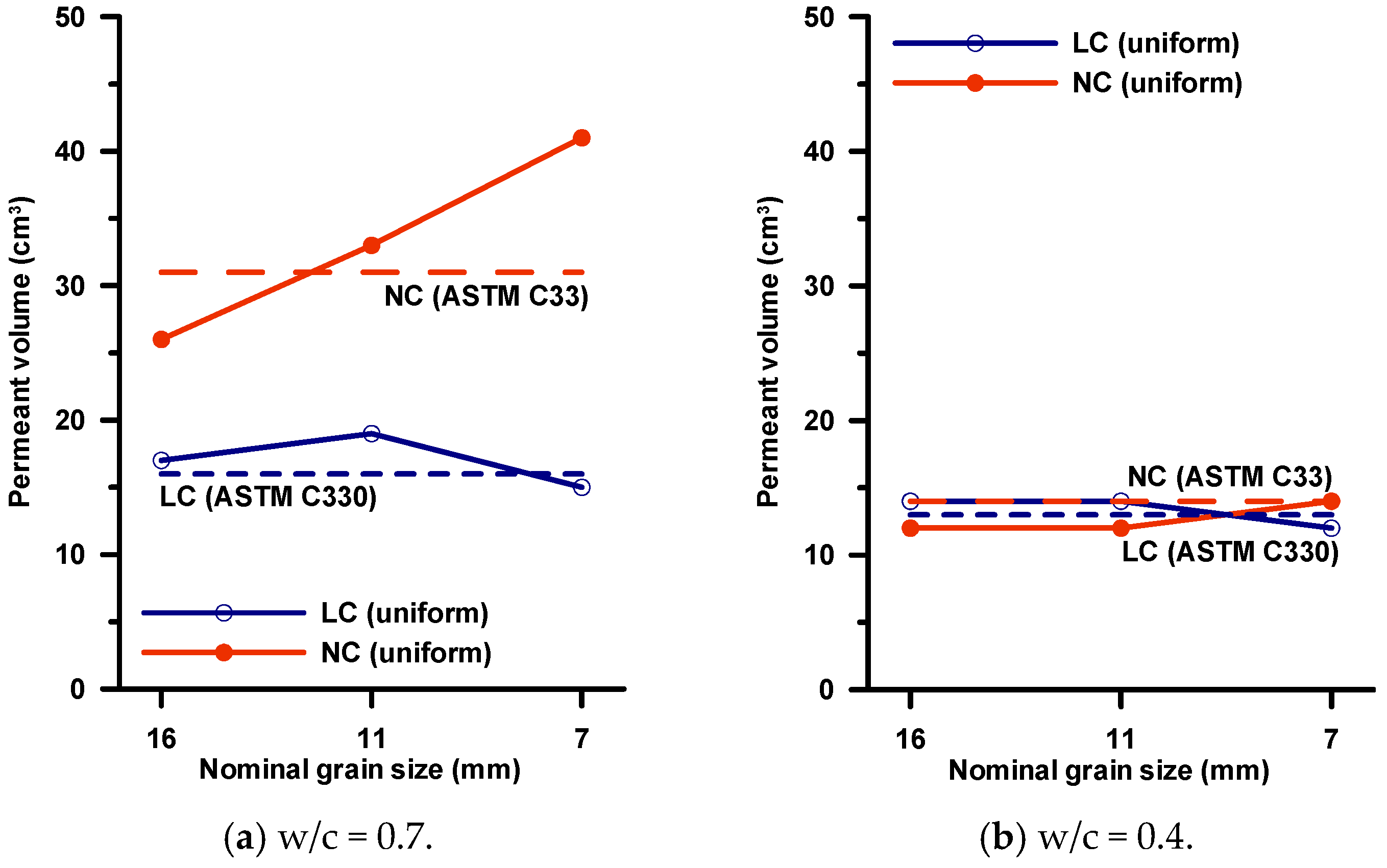
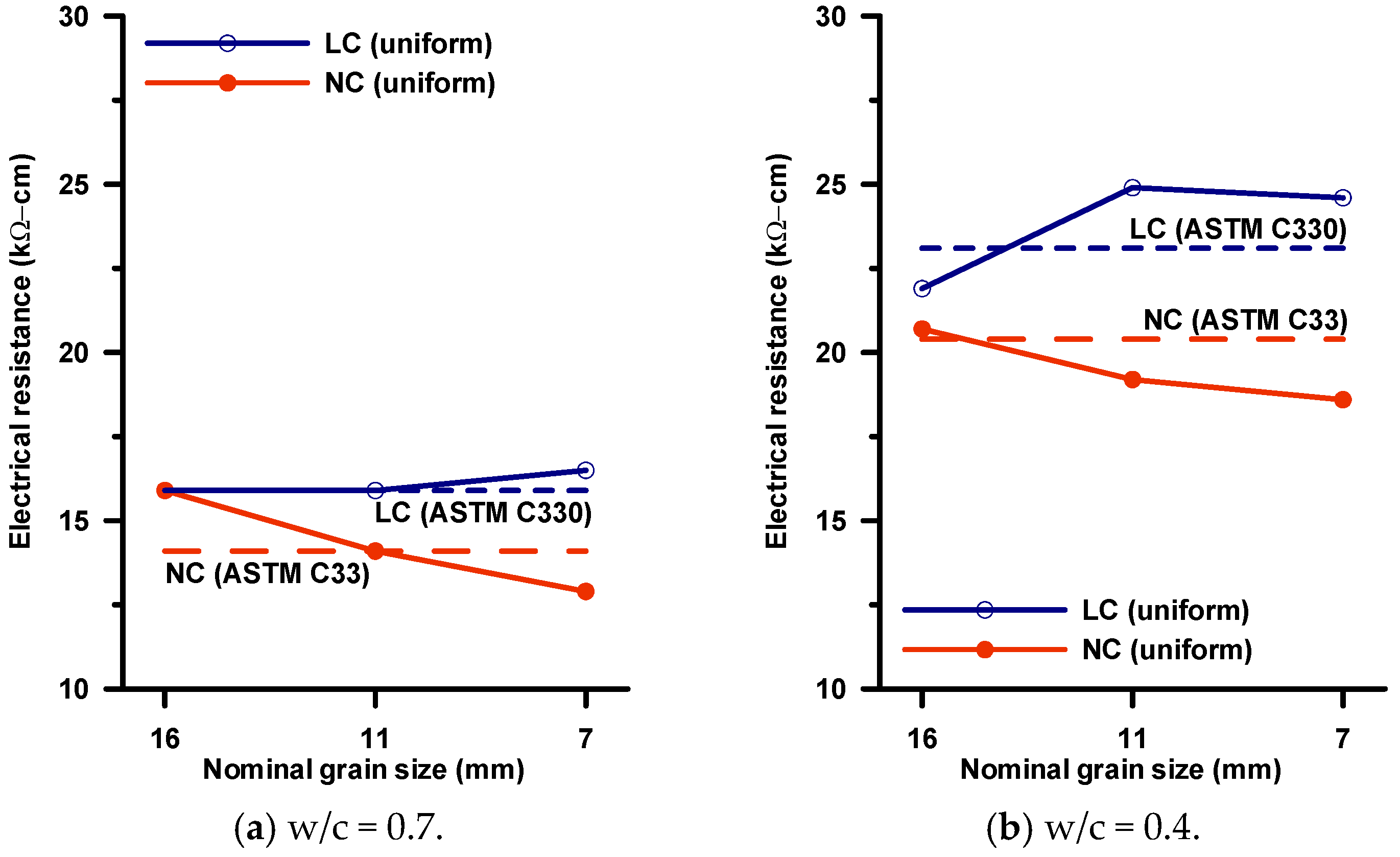
| Grain Size (mm) | Nominal Grain Size (mm) | Particle Density (kg/m3) | 24 h Water Absorption (%) |
|---|---|---|---|
| 12.5–19 | 16 | 1460 | 8.77 |
| 9.5–12.5 | 11 | 1460 | 8.00 |
| 4.75–9.5 | 7 | 1490 | 7.12 |
| Gradation | Amount (%) | SSA (m2/m3) | ||
|---|---|---|---|---|
| 19–12.5 mm | 12.5–9.5 mm | 9.5–4.75 mm | ||
| Standard gradation (S) | 40 | 30 | 30 | 573 |
| Nominal grain size 16 mm | 100 | 0 | 0 | 381 |
| Nominal grain size 11 mm | 0 | 100 | 0 | 545 |
| Nominal grain size 7 mm | 0 | 0 | 100 | 857 |
| Item | w/c | Cement | Water | Normal Weight Fine Aggregates | Lightweight Coarse Aggregates (Oven-Dried) | ||
|---|---|---|---|---|---|---|---|
| 19–12.5 mm | 12.5–9.5 mm | 9.5–4.75 mm | |||||
| L0.7-S | 0.7 | 290 | 202 | 721 | 239 | 179 | 183 |
| L0.7-16 | 598 | 0 | 0 | ||||
| L0.7-11 | 0 | 597 | 0 | ||||
| L0.7-7 | 0 | 0 | 609 | ||||
| L0.4-S | 0.4 | 480 | 194 | 667 | 221 | 165 | 169 |
| L0.4-16 | 552 | 0 | 0 | ||||
| L0.4-11 | 0 | 551 | 0 | ||||
| L0.4-7 | 0 | 0 | 562 | ||||
| Item | w/c | Cement | Water | Normal Weight Fine Aggregates | Normal Weight Coarse Aggregates | ||
|---|---|---|---|---|---|---|---|
| 19–12.5 mm | 12.5–9.5 mm | 9.5–4.75 mm | |||||
| N0.7-S | 0.7 | 290 | 202 | 721 | 419 | 342 | 342 |
| N0.7-16 | 1103 | 0 | 0 | ||||
| N0.7-11 | 0 | 1103 | 0 | ||||
| N0.7-7 | 0 | 0 | 1103 | ||||
| N0.4-S | 0.4 | 480 | 194 | 667 | 387 | 316 | 316 |
| N0.4-16 | 1019 | 0 | 0 | ||||
| N0.4-11 | 0 | 1019 | 0 | ||||
| N0.4-7 | 0 | 0 | 1019 | ||||
| Item | Fresh Concrete | Hardened Concrete | Durability | |||
|---|---|---|---|---|---|---|
| Slump (mm) | Air Content (%) | Unit Weight (kg/m3) | Compressive Strength (MPa) | Permeant Volume (cm3) | Electrical Resistance (kΩ-cm) | |
| L0.7-S | 180 | 2.1 | 1857 | 23.8 | 16 | 15.9 |
| L0.7-16 | 220 | 1.5 | 1874 | 21.9 | 17 | 15.9 |
| L0.7-11 | 180 | 1.9 | 1852 | 24.5 | 19 | 15.9 |
| L0.7-7 | 130 | 2.1 | 1901 | 26.3 | 15 | 16.5 |
| N0.7-S | 160 | 1.0 | 2351 | 24.0 | 31 | 14.1 |
| N0.7-16 | 200 | 0.8 | 2361 | 21.4 | 26 | 15.9 |
| N0.7-11 | 130 | 1.5 | 2349 | 23.1 | 33 | 14.1 |
| N0.7-7 | 70 | 1.7 | 2344 | 23.9 | 41 | 12.9 |
| L0.4-S | 60 | 2.5 | 1937 | 44.8 | 13 | 23.1 |
| L0.4-16 | 65 | 2.1 | 1925 | 38.6 | 14 | 21.9 |
| L0.4-11 | 60 | 2.2 | 1936 | 43.7 | 14 | 24.9 |
| L0.4-7 | 45 | 2.2 | 1943 | 57.8 | 12 | 24.6 |
| N0.4-S | 35 | 2.2 | 2399 | 53.1 | 14 | 20.4 |
| N0.4-16 | 60 | 1.7 | 2399 | 52.0 | 12 | 20.7 |
| N0.4-11 | 45 | 1.6 | 2382 | 50.6 | 12 | 19.2 |
| N0.4-7 | 25 | 1.9 | 2387 | 54.2 | 14 | 18.6 |
© 2018 by the authors. Licensee MDPI, Basel, Switzerland. This article is an open access article distributed under the terms and conditions of the Creative Commons Attribution (CC BY) license (http://creativecommons.org/licenses/by/4.0/).
Share and Cite
Chen, H.-J.; Wu, C.-H. Influence of Aggregate Gradation on the Engineering Properties of Lightweight Aggregate Concrete. Appl. Sci. 2018, 8, 1324. https://doi.org/10.3390/app8081324
Chen H-J, Wu C-H. Influence of Aggregate Gradation on the Engineering Properties of Lightweight Aggregate Concrete. Applied Sciences. 2018; 8(8):1324. https://doi.org/10.3390/app8081324
Chicago/Turabian StyleChen, How-Ji, and Chung-Hao Wu. 2018. "Influence of Aggregate Gradation on the Engineering Properties of Lightweight Aggregate Concrete" Applied Sciences 8, no. 8: 1324. https://doi.org/10.3390/app8081324
APA StyleChen, H.-J., & Wu, C.-H. (2018). Influence of Aggregate Gradation on the Engineering Properties of Lightweight Aggregate Concrete. Applied Sciences, 8(8), 1324. https://doi.org/10.3390/app8081324





